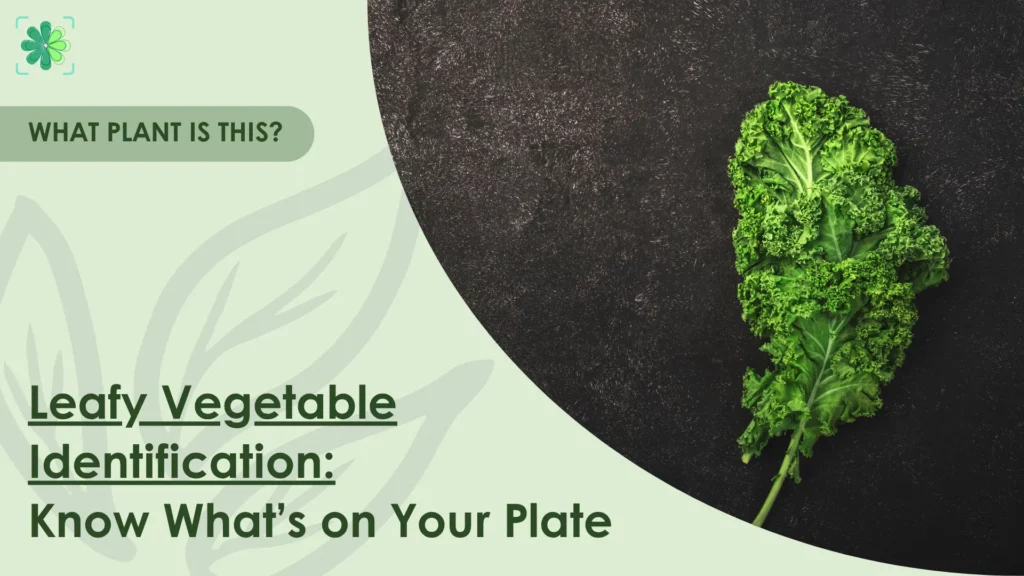
Leafy vegetable identification helps you recognize what’s really on your plate, beyond just lettuce. From crinkled kale to peppery arugula and smooth spinach, leafy greens come in a variety of shapes, colors, and textures. This guide categorizes them by family, shows how to distinguish between lookalikes, and provides quick tips for cooking and storing them. You’ll also learn how to use visual clues and identification tools to confidently identify each type.
What Are Leafy Vegetables?
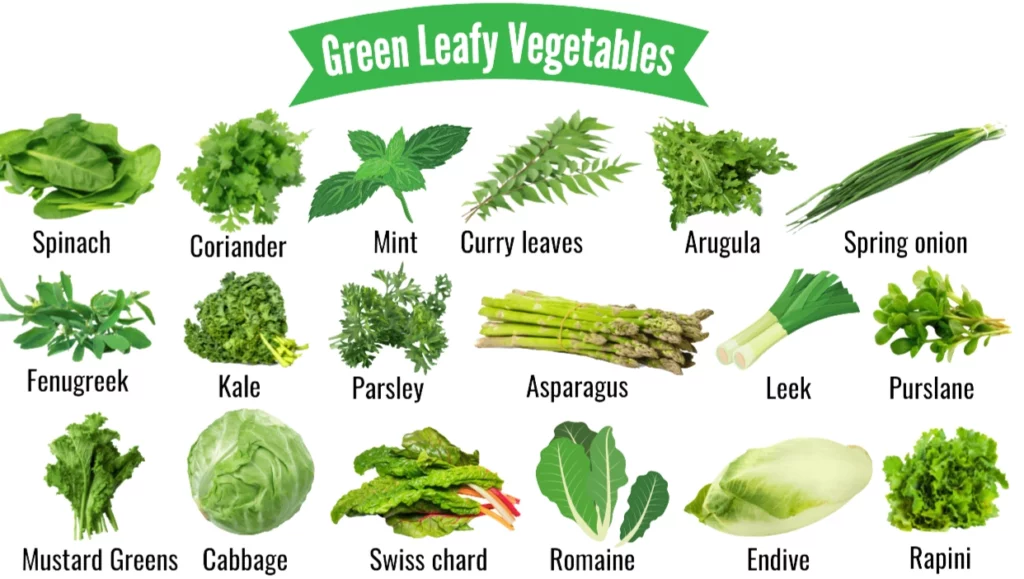
Leafy vegetables are the edible leaves of various plants, enjoyed both raw and cooked. They’re not just limited to lettuce. They span multiple plant families and come in a wide range of shapes, textures, and flavors. These greens play a crucial role in many cuisines due to their versatility and nutritional value.
What sets them apart is:
- High in nutrients like vitamins A, C, K, folate, and fiber
- Low in calories but filling due to their fiber content
- Great in many dishes: salads, soups, smoothies, stir-fries, or steamed
For better leafy vegetable identification, it’s helpful to group them into broad categories:
- Lettuce & Chicory types – romaine, arugula, endive, radicchio
- Brassica family – kale, mustard greens, collards, bok choy
- Other greens – spinach, Swiss chard, watercress, microgreens
- Herbaceous leaves – parsley, cilantro, dill (often used in small amounts but still edible greens)
Knowing which group a leafy green belongs to can make it easier to recognize, use, and store them properly.
Leafy Greens by Category (with Examples)
Leafy greens come in many shapes, textures, and flavors, but once you know their categories, identifying them becomes much easier. Let’s break down the most common types you’ll come across.
Lettuce & Chicory Types
These are some of the most commonly consumed salad greens, prized for their crunch and mild or slightly bitter taste. They tend to be more delicate and are usually eaten raw.
- Romaine: Long, upright leaves with thick ribs and a crisp texture. The outer leaves are darker green, while the inner ones are pale and tender.
- Butterhead (Boston or Bibb): Soft, loose heads with a smooth texture and mild, buttery flavor. Great for wraps or delicate salads.
- Iceberg: Pale green, densely packed heads. Very crunchy but low in flavor and nutrients compared to darker greens.
- Arugula (Rocket): Small, narrow, and lobed leaves with a sharp, peppery bite. Common in Mediterranean dishes.
- Endive & Escarole: Broad, curly, or slightly pointed leaves. They add bitterness and texture to mixed salads or can be grilled.
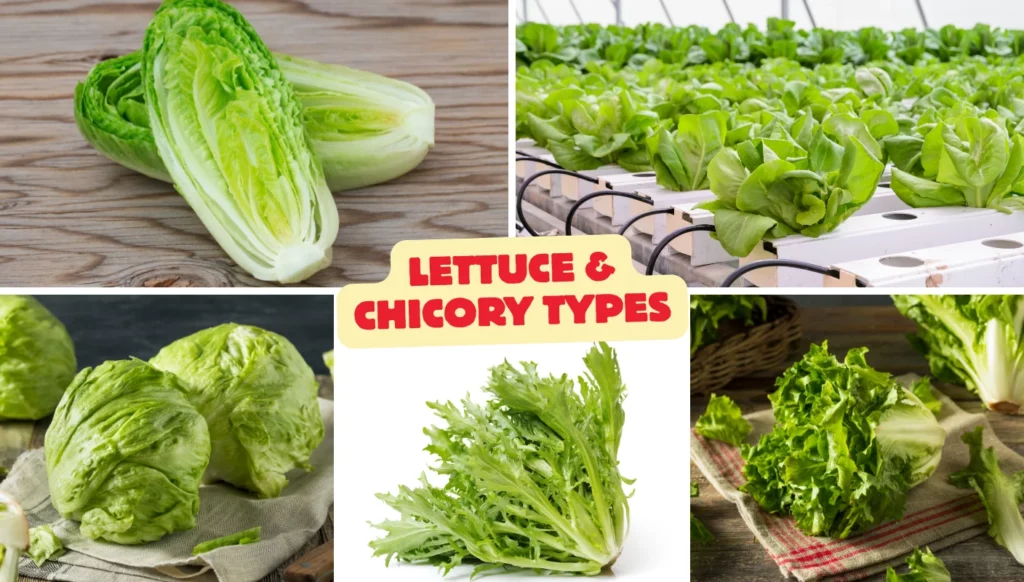
For this group, leafy vegetable identification often comes down to how the leaves grow (tight head vs. loose bunch), the taste (sweet, bitter, or peppery), and the shape of the leaves (rounded vs. jagged).
Brassica Family (Cabbage Relatives)
Brassicas are a tougher, more fibrous group of leafy greens that are often cooked rather than eaten raw. They come from the same botanical family as cabbage, broccoli, and cauliflower.
- Kale: Ranges from curly to flat (“Lacinato” or dinosaur kale). Leaves are deep green or even purple, with a bumpy texture and earthy taste.
- Collard Greens: Large, flat, oval leaves with thick stems. Mild in flavor but sturdy enough for long cooking.
- Mustard Greens: Frilly or deeply lobed leaves with a strong, spicy flavor, excellent in stir-fries or soups.
- Bok Choy: A Chinese cabbage with crunchy white stalks and dark spoon-shaped leaves. Mild in flavor and quick to cook.
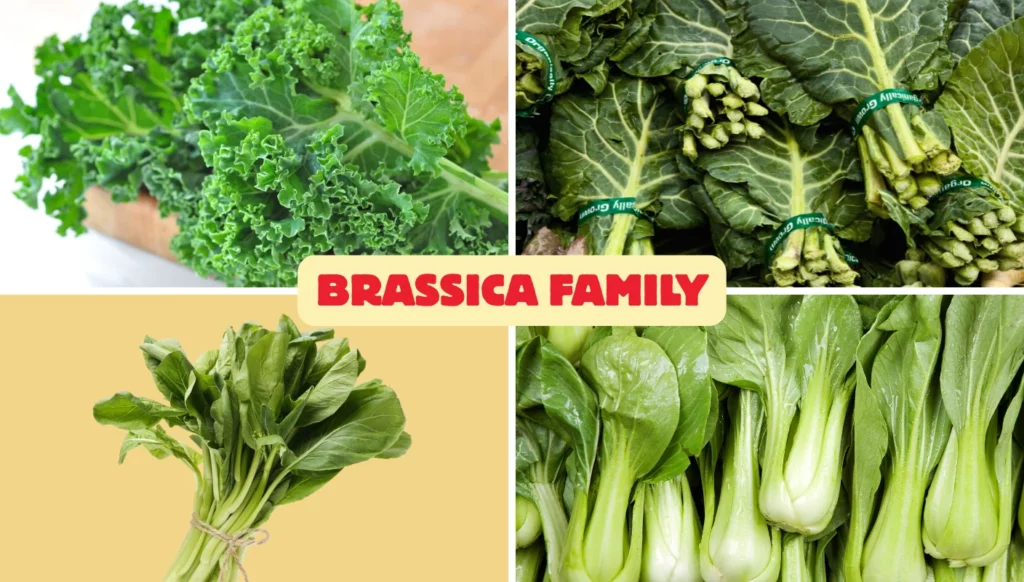
In terms of leafy vegetable identification, brassicas can often be recognized by their slightly waxy surface, pronounced veins, and their ability to hold up to heat without falling apart.
Other Common Greens
These greens don’t fall under the categories of lettuce or brassicas, but are essential in many global cuisines. They vary widely in texture, color, and flavor intensity.
- Spinach: Smooth or slightly crinkled leaves, typically dark green. Tender enough for raw salads but also holds up well to sautéing and steaming.
- Swiss Chard: Large, wrinkled leaves with vibrant, colorful stems (red, yellow, pink, or white). Slightly earthy taste, often used in Mediterranean cooking.
- Watercress: Small, rounded leaves with thin stems and a peppery flavor. High in antioxidants and often used raw in sandwiches or salads.
- Microgreens: Young, sprouted seedlings of vegetables like radish, kale, or beet. Tiny but packed with flavor and nutrients.
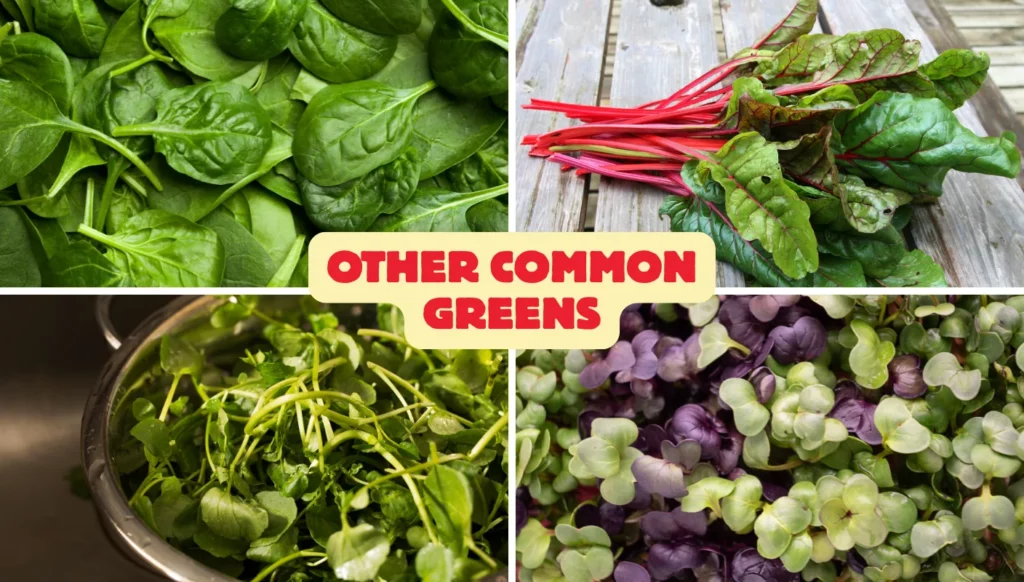
Color is a big clue in leafy vegetable identification here. Watch for the rich greens of spinach, the rainbow stems of chard, and the delicate size of microgreens.
Herbaceous Leaves (Edible Herbs)
These leafy herbs are often used as garnishes or seasonings, but many are also eaten in larger quantities, especially in certain cultures where they act as base greens.
- Parsley: Comes in curly and flat-leaf (Italian) varieties. Clean, fresh flavor and sturdy texture.
- Cilantro: Delicate, deeply notched leaves. Used widely in Latin American and Southeast Asian dishes.
- Dill: Fine, feathery leaves with a distinctive aroma, pairs well with fish and dairy.
- Shiso, Mint, and Basil: Broad or toothed leaves, often used in wraps or salads. Each has a strong, distinct flavor profile.
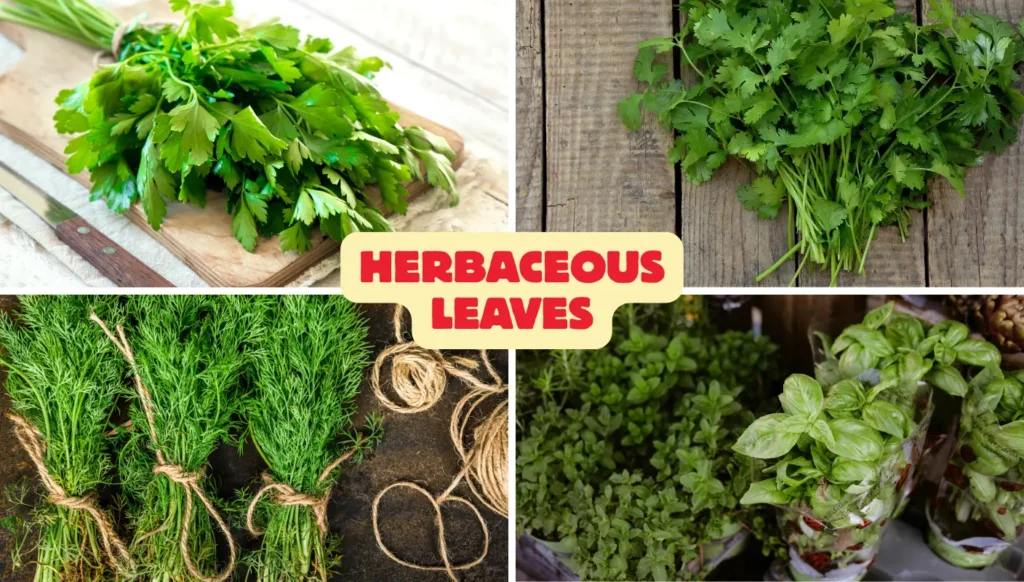
While not always considered vegetables, these herbs are still an essential part of leafy vegetable identification, mainly when used in large quantities or cooked into dishes.
How to Visually Identify Leafy Vegetables?
Four key traits help with leafy vegetable identification:
Leaf Shape and Size
Leaf shape can reveal a great deal about the type of vegetable and even hint at its flavor or texture. Pay attention to:
- Overall shape: Some leaves are broad and rounded (like butterhead lettuce), while others are long and narrow (like mustard greens). Some are spoon-shaped, oval, or even arrow-like.
- Edges: Are the edges smooth and plain, or do they have little waves, curves, or deep cuts? Curly or frilly edges often accompany stronger-flavored greens, while smooth-edged leaves tend to be milder.
- Lobes and notches: Some greens, such as arugula or oak leaf lettuce, have deeply lobed edges that give the leaves a look reminiscent of tiny hands or feathers.
- Size: Young greens and microgreens are very small and delicate, while mature greens, such as collards or Swiss chard, can have huge, broad leaves that can be over a foot long.
Texture
Texture refers to the way a leaf feels and its behavior when handled or cooked. This can help you decide whether a green is best eaten raw or cooked.
- Tender: Soft, flexible leaves (like spinach or baby lettuce) are great in salads and don’t need much cooking.
- Crisp: Leaves like romaine or iceberg are firm and break with a snap. These are often used for crunch in sandwiches or wraps.
- Fibrous or sturdy: Thick leaves, like those of kale or collards, have a bit of chew. They hold up well in stir-fries, soups, or braises.
- Velvety or fuzzy: Some greens, like lamb’s lettuce (mâche), have a soft, almost suede-like surface. These are more delicate and are usually eaten raw.
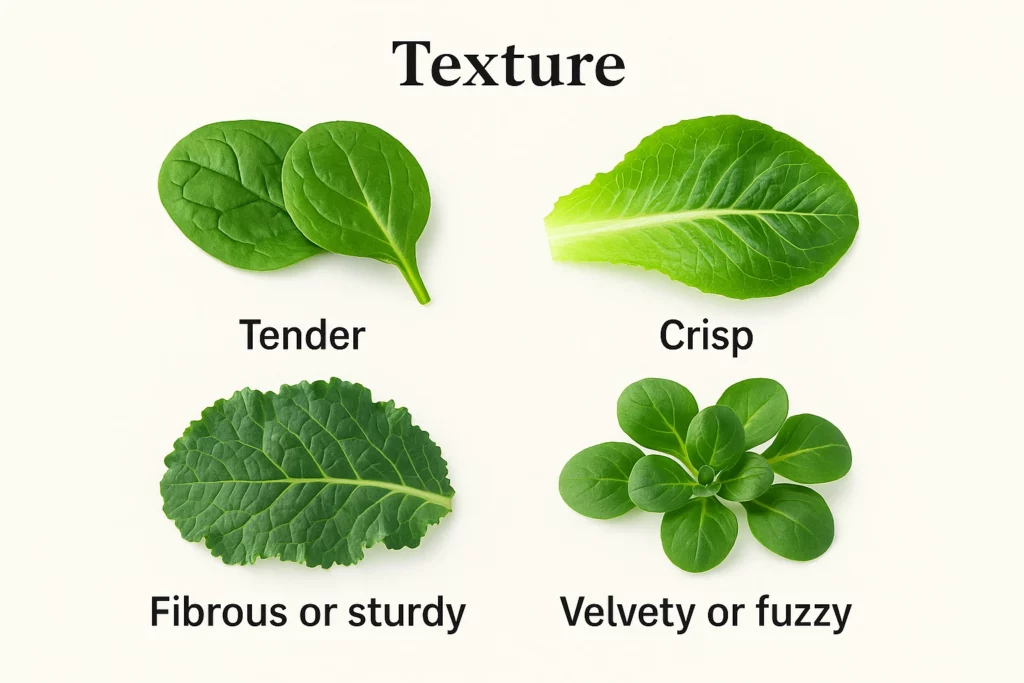
Color
Green is the most common color, but there’s more variety than people often expect. Leaf color can signal both the nutrient content and the strength of flavor.
- Light green: Usually found in young leaves or tender varieties. These greens tend to have a mild, sweet flavor.
- Dark green: Found in mature spinach, kale, and chard. Often richer in iron and other nutrients. The flavor may also be earthier or more bitter.
- Red, purple, or burgundy tones: Seen in greens like radicchio, red mustard, or red-veined sorrel. These colors often signal bitterness or spiciness.
- Color contrast: Some greens have one color in the leaf and another in the stem or veins (e.g., rainbow chard). These markings help confirm what you’re looking at.
Growth Habit
Examining how the plant grows provides context that leaf shape alone cannot offer. This is especially helpful when identifying plants in gardens or markets.
- Head-forming: The leaves grow tightly packed in a round or oval shape, like romaine or cabbage. These are usually harvested whole.
- Rosette: Leaves spread out in a circular pattern close to the ground. You’ll see this in plants like spinach, dandelion, or butterhead lettuce.
- Loose-leaf or bunching: The leaves grow upward and outward without forming a tight head. Greens like kale, mustard, and chard are grown this way and harvested leaf by leaf.
- Trailing or climbing: Some leafy greens, like water spinach or sweet potato greens, grow along the ground or climb upward. This habit isn’t as common but can be a strong ID clue in tropical or Asian varieties.
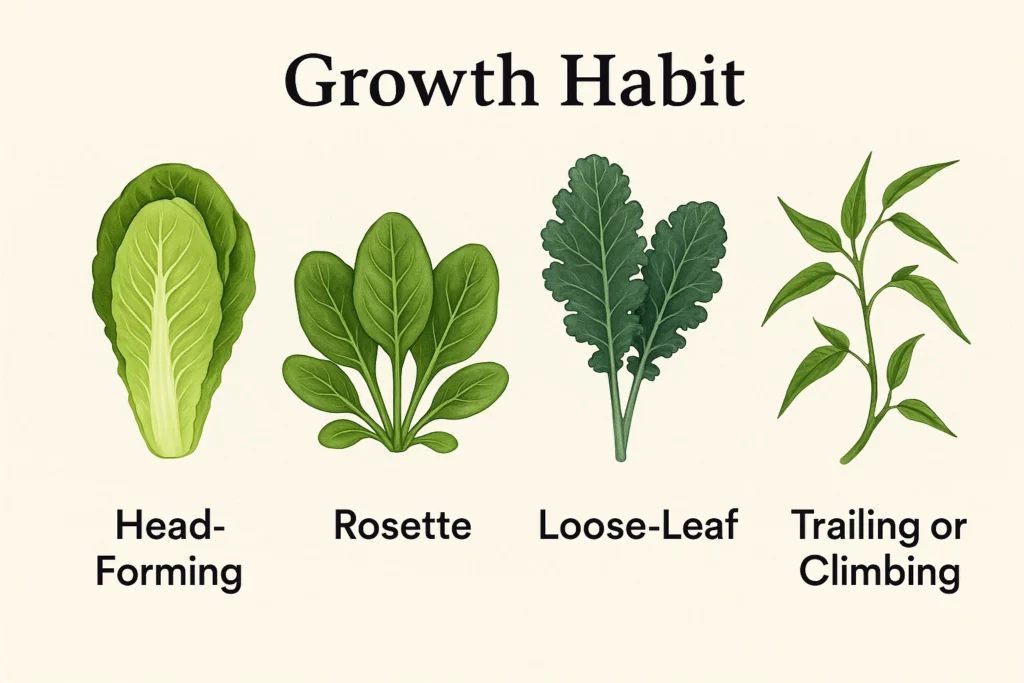
How to Tell Similar Leafy Greens Apart
| Leafy Green Pair | Similarities | Differences |
| Arugula vs. Dandelion | Both have deeply lobed, slender leaves | Arugula is softer with a nutty, peppery flavorDandelion is tougher and more bitter |
| Spinach vs. Baby Chard | Smooth, rounded leaves; similar size when young | Baby chard has red/pink stems and glossy leavesSpinach is matte with pale green stems |
| Mustard Greens vs. Kale | Both can have frilly or curly edges | Mustard greens taste spicy and sharpKale is more mild and chewy |
| Young Seedlings vs. Weeds | Small, generic-looking green sprouts | True seedlings develop symmetrical ‘true’ leavesWeeds often grow faster and look uneven |
Nutrition and Kitchen Uses of Leafy Veggies
We all know that leafy vegetables are extremely beneficial for our health. Most leafy greens are high in:
- Vitamin K – essential for blood clotting and strong bones
- Vitamin A – supports eye health and immune function
- Vitamin C – boosts immunity and helps iron absorption
- Folate (B9) – important for DNA repair and prenatal health
- Iron, calcium, magnesium – key minerals for energy, bone health, and muscle function
- Antioxidants – including beta-carotene, lutein, and polyphenols that protect cells from damage
- Fiber – improves digestion, lowers cholesterol, and keeps you full longer
Top Nutrient-Dense Leafy Greens
| Leafy Green | Nutritional Highlights (per 100g) | Health Benefits | Best Uses | Storage Tips |
| Kale | Vit K: 370% DV, Vit A: 206%, Vit C: 134%, manganese, fiber, antioxidants | Detox support, heart health, anti-inflammatory, supports vision | Sauté, smoothies, baked chips | Wrap in a damp towel, refrigerate loosely |
| Spinach | Vit K: 403%, Folate: 49%, Vit A: 188%, Vit C: 47%, iron, magnesium | Iron boost, brain and eye support, blood pressure control | Salads, sautés, green smoothies | Paper wrap, store in produce drawer |
| Swiss Chard | Vit K: 477%, Vit A: 122%, Vit C: 50%, magnesium, potassium, beta-carotene | Balances blood sugar, supports bones and muscle function | Stir-fry, steamed, mixed with grains | Keep slightly moist, use within 4–5 days |
| Watercress | Vit K: 238%, Vit C: 72%, Vit A: 64%, calcium, antioxidants, glucosinolates | Powerful antioxidant, protects heart, reduces inflammation | Raw in salads, sandwiches, smoothies | Use within 2–3 days, wrapped in damp paper |
| Collard Greens | Vit K: 339%, Vit A: 90%, Vit C: 59%, calcium: 23%, fiber | Bone health, cholesterol control, rich in plant protein | Braised, added to soups or rice dishes | Wrap in towel, store up to 5 days |
| Beet Greens | Vit A: 127%, Vit K: 400%+, Vit C: 50%, magnesium, iron, potassium | Supports muscle health, reduces oxidative stress | Sautéed, added to stir-fries or soups | Rinse, wrap loosely, store in fridge |
| Mustard Greens | Vit K: 500%+, Vit A: 118%, Vit C: 65%, calcium, antioxidants, spicy flavor | Immunity, digestion, cancer-protective compounds | Light stir-fry, southern-style stews | Keep in crisper with damp towel |
| Fenugreek (Methi) | Calcium: 180 mg/cup, protein: ~4g/100g, iron, fiber | Plant-based protein, supports bones and digestion | Indian stir-fries, cooked with lentils | Use fresh within 2–3 days |
DV = Daily Value. Percentages based on USDA and research-backed data for 100g fresh, raw leaves.
Conclusion
In the end, once you understand leafy vegetable identification, you’ll never look at a salad mix or garden bed the same way again. It’s a practical skill that helps with both nutrition and cooking. Download the Planteyes app to keep a smart plant ID guide right in your pocket.
FAQs
What’s the easiest way to tell kale from collards?
Look at the leaf shape and texture. Kale has curly or crinkled edges and a bumpy surface, while collard greens have smooth, flat, broad leaves with a matte finish. Kale is also more tender when young, whereas collards stay thick and sturdy.
Are microgreens different from sprouts?
Yes. Microgreens are young seedlings grown in soil and harvested after the first true leaves appear (7–21 days). Sprouts are germinated seeds eaten earlier (2–7 days), usually with no soil and often consumed whole, including the seed. Microgreens are more nutrient-dense and flavorful.
Is there an app to identify leafy greens by photo?
Yes. Apps like Planteyes allow you to take a photo and get instant ID suggestions. These tools are especially helpful for leafy vegetable identification in markets or gardens.
Which leafy greens grow best in small home gardens?
Fast-growing, compact varieties like lettuce (butterhead, romaine), arugula, spinach, and kale do well in containers or raised beds. They prefer cool weather and partial sun, making them ideal for spring and fall planting. Harvest outer leaves regularly to keep them growing.


